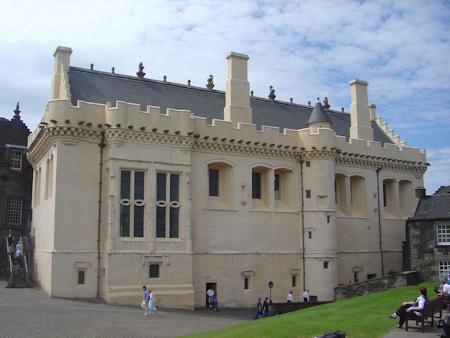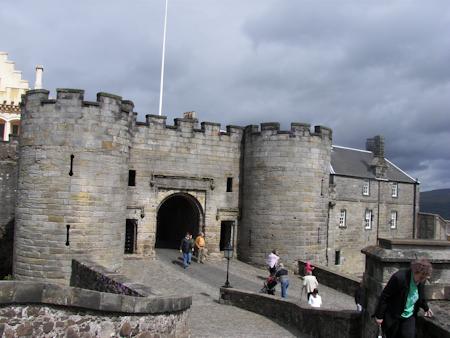
Stirling Castle
Sitting high on a volcanic outcrop with towering cliffs on three sides Stirling Castle has a long and illustrious history as one of Scotland's most important royal castles.
The story of Stirling Castle begins in the early 12th Century when King Alexander I gave financial support for a chapel in the castle grounds. It is possible that there were earlier fortifications here, but there is no archaeological evidence for anything before the 14th Century.
Stirling was a royal castle almost from the beginning. Alexander I died here in 1124 and his son King David I made Stirling a royal burgh and a key administrative centre for the region. No doubt there would have been a number of high-status buildings for royal accommodation and government. It is thought that the highest point, now the Douglas Gardens, could have been the site of the original king's hall. All the buildings were timber at this time, except the chapel.
King William I built a deer-park to the south-west of the castle to maintain good stocks for the hunt. However, in 1174 Stirling Castle was surrendered to Henry II of England as part of a deal to secure William's release. The English never occupied the castle and Richard I of England later handed it back to the Scottish Crown.
Wars of Independence
As a royal stronghold Stirling was at the centre of the Wars of Scottish Independence in the early 14th Century. It was besieged repeatedly, including at least twice by forces commanded by Robert the Bruce (King Robert I of Scotland) and changed hands a number of times.
One of the key sieges was during 1313-1314. Sir Philip Mowbray held the castle on behalf of Edward II of England. When Edward Bruce, Robert I's brother, laid siege to Stirling, Mowbray offered him a deal. If Mowbray was not relieved by English forces by Midsummer's Day 1314 he would surrender the castle.
Edward II was unwilling to give up the castle and marched a large army north from Berwick-upon-Tweed on the 17th of June 1314. The two armies met at the Battle of Bannockburn, just a few miles from Stirling, on June 24th. It was a decisive Scottish victory and one of the key battles for Scottish Independence.
Mowbray duly gave up the castle as agreed and changed sides in the process. Robert the Bruce ordered that Stirling Castle be slighted to prevent the English from reoccupying it. That didn't work and a few years later the English under Edward III of England recaptured it and made numerous repairs and extensions to the castle. Most of the work was still being done in timber rather than stone though.
In 1342 Robert Stewart, who later became King Robert II of Scotland, retook Stirling and held on to it until the end of the war in 1357.
A Royal Residence
Robert II came to power in 1371 and he was the first of the royal Stewart dynasty. He repaired the siege damage and constructed the new North Gate. Stirling again became a favoured royal residence. James I gave the castle to his queen and so began a tradition that made Stirling into a kind of royal nursery.
It was James IV who built most of Stirling Castle as we see it today. He saw himself as being as important as Louis XII of France and Henry VII of England and he set about building a glittering royal court at Stirling.
He constructed the Great Hall, the Chapel Royal, the King's Old Building which he turned into a sumptuous royal residence, and the Forework entrance and defences. His court had all the fashionable services of the time; musicians, poets and even an alchemist for a few years.
His son, James V, built his Renaissance Palace around 1538. He had spent time in Europe and he brought these new foreign ideas, materials and skilled craftsmen back to his Scottish court. Although it was mostly complete by the time of his death in 1542, he may never actually have seen his palace in its full glory.
Mary, Queen of Scots
When James V died his only heir was his six-day-old daughter Mary. She was crowned Queen of Scots on 9th September 1543 in the Chapel Royal and it was the first time the Honours of Scotland (crown, sceptre and sword) were all used together.
The infant queen and her mother Mary of Guise stayed at Stirling. Her mother held court and fought to protect her daughter's interests. She built up her support, became regent, and successfully paved the way for Mary Queen of Scots to rule Scotland in her own right.
In September 1565 Mary brought her infant son, Prince Charles James, to the secure royal nursery in Stirling Castle and the next year saw three days of spectacular celebrations, including the first ever firework display in Scotland, to celebrate James' baptism with a full Catholic rite.
Mary Queen of Scots abdicated in 1567 and the infant James became a focus for rival factions competing for power. Stirling Castle was attacked in 1571 and again in 1578. By 1583 it was in quite a sorry state with many of the buildings close to collapse from a lack of proper maintenance.
In 1594 James (now King James VI of Scotland) replaced the Chapel Royal with a new building with an elegant Classical design. It was used for the baptism of his son Prince Henry which again saw a big celebration in the Great Hall.
In 1603 James VI of Scotland inherited the English throne when Queen Elizabeth I died. He moved south and though he promised to return often he only came back once.
When his son Charles I took the throne he was expected to visit. A programme of works was undertaken to make the castle suitable for a king once more. The Great Hall, Chapel Royal and the Palace were artistically repainted and the doorways and fireplaces were marbled. Charles did finally visit for a short time in 1633, but the palace was uninhabited for most of the 17th Century.
Military Stronghold and Barracks
With the royals away the military side of the castle came to the fore once more. The English Civil War saw Stirling besieged and taken in 1651 by General Monck of the parliamentary army. The scars from his artillery can still be seen on the Forework today.
The Jacobite Uprisings forced improvements to the castle defences. The first were hastily undertaken in 1689 and involved the closure of two back entrances and the installation of artillery emplacements on the east side. The second programme was undertaken with more care between 1708 and 1714.
In 1746 those defences were tested when Bonnie Prince Charlie's army laid siege to the castle. The new defences worked and the Jacobite's artillery emplacements didn't last long under the fire from Stirling's batteries.
By the end of the 18th Century the castle was allowed to fall into disrepair. In 1777 the King's Inner Hall collapsed and it was simply removed.
In 1794 the Duke of Argyll's Highland regiment moved in and converted the Great Hall into a barracks. During the 1800s the castle was gradually converted to a military base and a number of new buildings were constructed including the Main Guard House.
Restoration
In 1964 the Argyll and Sutherland Highlanders moved out and the Office of Works (now Historic Scotland) were able to undertake major preservation work. Its virtual abandonment by the royals and the relatively benign neglect by the army meant that today Stirling Castle has one of the finest collections of late-medieval and Renaissance royal buildings in Europe.
The castle is still run by Historic Scotland and welcomes visitors. Visitors can see the Palace as it would have been in James V's time. The Great Hall has been restored to its former splendour and the Chapel Royal is open. The castle is also host to the Regimental Museum of the Argyll and Southern Highlanders which tells visitors about their long and distinguished history.
The castle stages a programme of events throughout the year and can cater for weddings and corporate event days too.
Facilities at the castle include toilets, a gift shop, audio and guided tours and information boards. Historic Scotland is also committed to providing good disabled access with a range of facilities for wheelchair users and disabled visitors.
Status: Visitor Attraction
Owner: Historic Scotland
Tel: +44 (0)1786 450 000
Email: hs.stirlingcastle@scotland.gsi.gov.uk
Website: www.stirlingcastle.gov.uk
Opening Times: April to September Daily 9.30am to 6pm / October to March Daily 9.30am to 5pm


Looking up the cliffs at the southern side of Stirling Castle

The Great Hall

The castle gatehouse